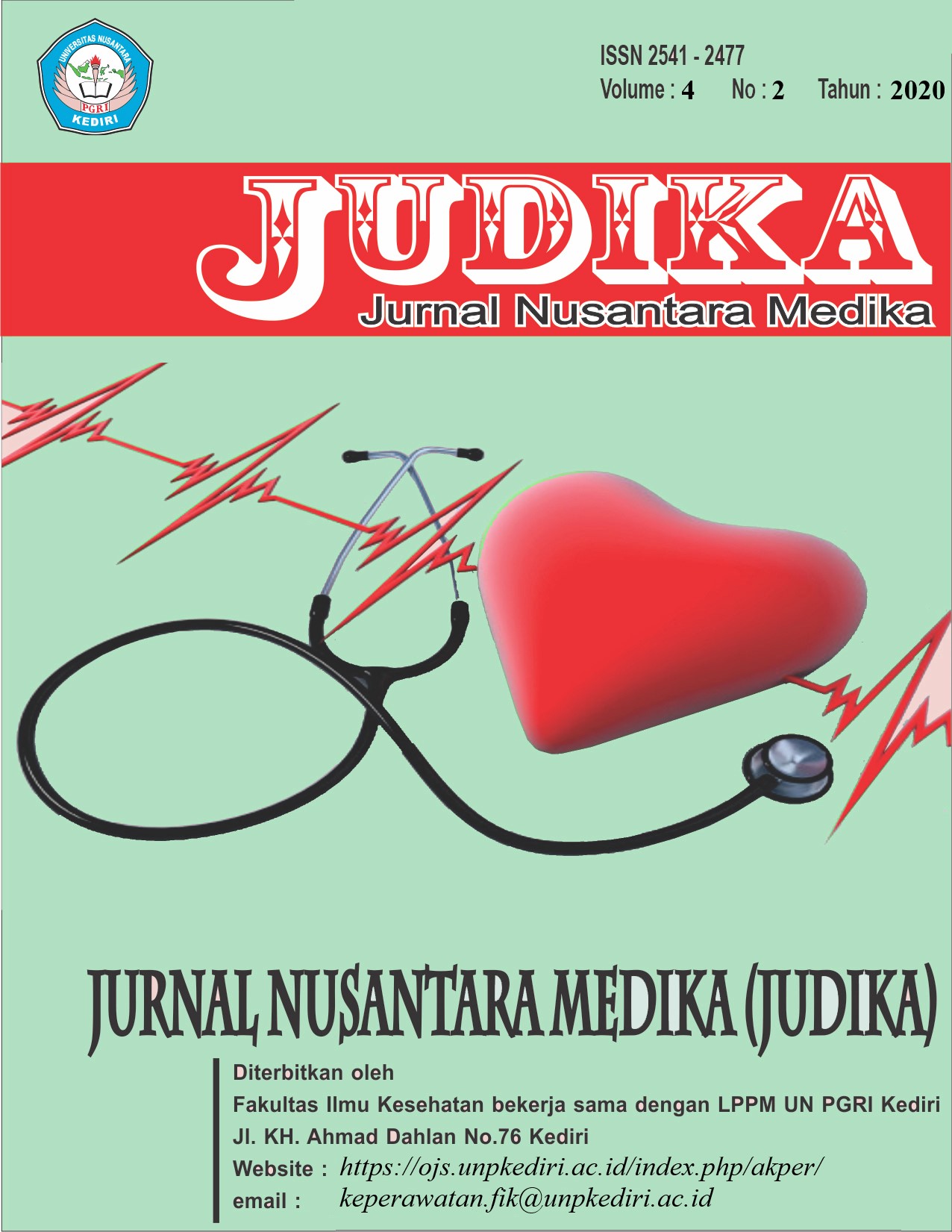Pijat Punggung dan Pemberian Aromaterapi Clarysage Terhadap Nyeri Persalinan Pada Ibu Bersalin
DOI:
https://doi.org/10.29407/judika.v4i2.14866Keywords:
Back Massage, Clary Sage Aromatherapy, Labor PainAbstract
Various efforts can reduce labor pain, both pharmacologically and non-pharmacologically. One non-pharmacological method is to use massage and aromatherapy which is cheaper, simpler, effective and without adverse effects. Pain is subjective for each individual, but if it is not resolved properly it will cause maternal morbidity, and will increase maternal mortality. The purpose of this study was to determine differences in the effectiveness of back massage and the administration of Clary Sage aromatherapy to labor pain in the active phase of the first phase of labor. The research design used was pre-experimental. The population studied was all mothers in the active phase of the first phase of 24 people with a purposive sampling technique with a sample of 10 people. The research instrument used was a numerical rating scale and observation sheet. The results of the study were analyzed using paired sample tests. The results of the study showed that most women who had back massages experienced moderate pain on a scale of 4, while those given Clary Sage aromatherapy experienced mild pain on a scale of 3. This is because massage stimulates the body to release endorphin compounds which are natural pain relievers . While clarysage aromatherapy can strengthen the respiratory system and muscles during labor, facilitate regular contractions, be effective to speed up the birth process, and reduce pain and tension. Based on the results of the analysis shows that there are differences in the effectiveness of back massage and the administration of Clary Sage aromatherapy to labor pain in the active phase of the first phase of labor.
Downloads
References
Ali, B., Al-wabel, N. A., Shams, S., Ahamad, A., Khan, S. A., & Anwar, F. (2015). Asian Paci fi c Journal of Tropical Biomedicine. Asian Pacific Journal of Tropical Biomedicine, 1–11. https://doi.org/10.1016/j.apjtb.2015.05.007
Anisyah Dwi Puspita. (2013). Analisis Faktor-Faktor yang Mempengaruhi Nyeri Persalinan pada Ibu Bersalin Kala I Fase Aktif di Puskesmas Mergangsan Tahun 2013. Stikes Aisyiah Yogyakarta.
Aprilia, Y. (2010). Hipnostetri. Jakarta: Gagas Media.
Barreto, R., Gallo, S., Santana, L. S., Homsi, C., Ferreira, J., Marcolin, C., … Quintana, S. M. (2013). Massage reduced severity of pain during labour : a randomised trial. Australian Journal of Physiotherapy, 59(2), 109–116. https://doi.org/10.1016/S1836-9553(13)70163-2
Bobak, L. . (2004). Buku Ajar Keperwatan Maternitas (4th ed.). Jakarta: EGC.
Can, H. O., & Saruhan, A. (2015). Evaluation of the effects of ice massage applied to large intestine 4 (hegu) on postpartum pain during the active phase of labor, 20(1), 129–138.
Chang, M., Wang, S., & Chen, C. (2002). Effects of massage on pain and anxiety during labour : a randomized controlled trial in Taiwan, 68–73.
Chapman, V. (n.d.). Asuhan Kebidanan Persalinan dan Kelahiran. Jakarta: EGC.
Chen, S., Wang, C., Chan, P., Chiang, H., Hu, T., Tam, K., & Loh, E. (2018). Labor pain control by aromatherapy : A meta-analysis of randomized controlled trials. Women and Birth. https://doi.org/10.1016/j.wombi.2018.09.010
Cheng, Y. W., Hopkins, L. M., & Caughey, A. B. (2004). How long is too long : Does a prolonged second stage of labor in nulliparous women affect maternal and neonatal outcomes ?, 1–6. https://doi.org/10.1016/j.ajog.2004.05.044
Danuatmadja, B. (2018). Persalinan Normal Tanpa Rasa Sakit :Tidak Harus Sakit untuk Menjadi Seorang Ibu. Jakarta: Puspa Swara.
Hajiamini, Z., Masoud, S. N., Ebadi, A., Mahboubh, A., & Matin, A. A. (2012). Complementary Therapies in Clinical Practice Comparing the effects of ice massage and acupressure on labor pain reduction q. Complementary Therapies in Clinical Practice, 18(3), 169–172. https://doi.org/10.1016/j.ctcp.2012.05.003
Henderson. (n.d.). Buku Ajar Konsep Kebidanan. Jakarta: EGC.
Kimber, L., Mcnabb, M., Court, C. M., Haines, A., & Brocklehurst, P. (2008). Massage or music for pain relief in labour : A pilot randomised placebo controlled trial, 12, 961–969. https://doi.org/10.1016/j.ejpain.2008.01.004
Maasumeh Kaviani, Sara Azima, Narges Alavi, M. H. T. (2014). The effect of lavender aromatherapy on pain perception and intrapartum outcome in primiparous women. British Journal Og Midwifery, 22(2).
Poeradisastra. (2014). Perawatan Wajah dan Tubuh Proa. Jakarta: Gramedia Pustaka Utama.
Rahmawati, W. R., Arifah, S., & Widiastuti, A. (n.d.). Pengaruh Pijat Punggung terhadap Adaptasi Nyeri Persalinan Fase Aktif Lama Kala II dan Perdarahan Persalinan pada Primigravida The Influence of Back Massage toward the Decrease of Labor Pain in Active Phase Length of Stage II and Labor Bleeding in Primigravida.
Sienkiewicz, M., Głowacka, A., Poznańska-kurowska, K., Kaszuba, A., Urbaniak, A., & Kowalczyk, E. (2015). The effect of clary sage oil on staphylococci responsible for wound infections, 21–26. https://doi.org/10.5114/pdia.2014.40957
Simkin, P., & Bolding, A. (2004). Update on Nonpharmacologic Approaches to Relieve Labor Pain and Prevent Suffering, 489–504. https://doi.org/10.1016/j.jmwh.2004.07.007
Tillett, J., & Ames, D. (2010). The Uses of Aromatherapy in Women ’ s Health, 24(3), 238–245.
Wiji Astuti, Heni Setyowati Esti Rahayu, K. W. (2015). Pengaruh Aromaterapi Bitter Orange Terhadap Nyeri dan Kecemasan Fase Aktif Kala I. The 2nd University Research Coloquium, 371–382.
Zwelling, E., Johnson, K., & Allen, J. (2006). Omplementary herapies, 31(December).
Downloads
Published
Issue
Section
License
Authors who publish with this journal agree to the following terms:
- Copyright on any article is retained by the author(s).
- The author grants the journal, right of first publication with the work simultaneously licensed under a Creative Commons Attribution License that allows others to share the work with an acknowledgment of the work’s authorship and initial publication in this journal.
- Authors are able to enter into separate, additional contractual arrangements for the non-exclusive distribution of the journal’s published version of the work (e.g., post it to an institutional repository or publish it in a book), with an acknowledgment of its initial publication in this journal.
- Authors are permitted and encouraged to post their work online (e.g., in institutional repositories or on their website) prior to and during the submission process, as it can lead to productive exchanges, as well as earlier and greater citation of published work.
- The article and any associated published material is distributed under the Creative Commons Attribution-ShareAlike 4.0 International License













